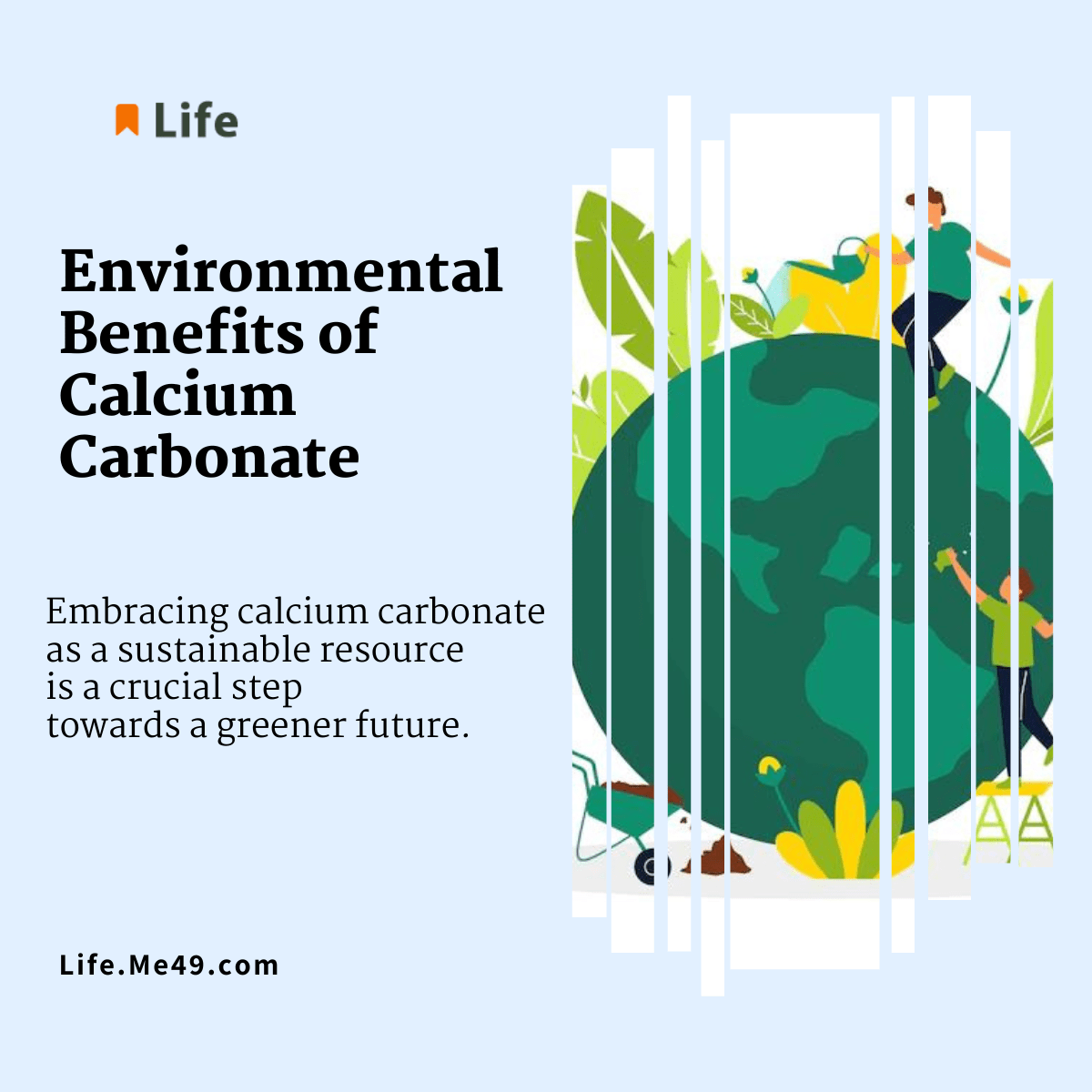Introduction; Environmental Benefits of Calcium Carbonate
In today’s age, characterized by an ever-increasing emphasis on environmental awareness and responsibility, various industries are perpetually in pursuit of innovative methods to diminish their carbon emissions and elevate their commitment to sustainability.
Amidst this noble endeavor, calcium carbonate, a remarkably versatile compound that occurs abundantly in the natural world, has emerged as a remarkable protagonist.
This article delves into the multifarious environmental advantages attributed to calcium carbonate, illuminating the extensive and intricate contributions it makes towards fostering a more ecologically conscious and sustainable future.
Harnessing Nature’s Bounty
Natural Abundance
Calcium carbonate, denoted by its chemical composition, CaCO3, is widely distributed throughout the natural world, predominantly manifesting in geological formations such as limestone, chalk, and marble.
The sheer prevalence of this compound in the Earth’s crust underscores its accessibility while inherently minimizing any adverse environmental ramifications associated with its extraction and utilization.
Its ready availability in these geological forms translates into a resource that can be harnessed with utmost regard for environmental preservation and sustainability.
Renewable Resource
In contrast to certain synthetic compounds that are finite and non-renewable, calcium carbonate stands apart as a perpetually replenishing resource.
This exceptional attribute is rooted in its ability to be perpetually extracted from quarries and mines, rendering it an inexhaustible wellspring for a diverse array of industries.
This perpetual availability not only distinguishes calcium carbonate as a sustainable option but also affords industries the confidence that their utilization of this mineral does not compromise the well-being of future generations.
Its renewability, therefore, underscores its enduring value as a resource that can be responsibly tapped into for various industrial applications, thereby aligning economic progress with ecological conscientiousness.
Reduced Carbon Emissions
Carbon Capture
Among the myriad environmental advantages attributed to calcium carbonate, one of the most captivating and consequential is its remarkable capability to capture and sequester carbon dioxide (CO2).
When calcium carbonate is thoughtfully incorporated into industrial processes, it effectively acts as a carbon “sponge,” swiftly absorbing and subsequently immobilizing CO2 emissions.
This pivotal function serves as a robust shield, diligently thwarting the escape of CO2 into the atmosphere, where it would otherwise contribute to the burgeoning greenhouse effect and global warming.
This environmentally responsible trait underscores calcium carbonate’s pivotal role in mitigating climate change and reinforces its position as a catalyst for cleaner, more sustainable industrial practices.
Lower Energy Consumption
The production of calcium carbonate stands out as an exemplar of energy efficiency when juxtaposed with the manufacturing processes associated with synthetic alternatives.
This distinction in energy demand translates into a tangible reduction in greenhouse gas emissions, a critical point of emphasis in our contemporary drive towards environmental sustainability.
This inherent efficiency in calcium carbonate production arises from its natural origins and the relatively straightforward processes involved in extracting and refining it.
As a result, the carbon footprint generated during its production is notably lower compared to the energy-intensive methods employed in the creation of synthetic alternatives.
This disparity not only underscores the environmental prudence of choosing calcium carbonate but also reinforces its status as a viable and eco-conscious alternative in various industrial applications.
The implications of this energy efficiency extend far beyond cost savings, directly contributing to the global effort to curb greenhouse gas emissions and combat climate change.
Thus, calcium carbonate emerges as a stalwart ally in the collective endeavor to forge a greener and more sustainable future.
Soil Stewardship
Soil pH Regulation
Calcium carbonate is an effective soil conditioner, used to regulate soil pH levels. By doing so, it enhances the fertility of agricultural land, leading to improved crop yields.
Reduced Soil Erosion
The use of calcium carbonate in agriculture helps mitigate soil erosion, preserving arable land and protecting against desertification.
Cleaner Waterways
Water Purification
Calcium carbonate is employed in water treatment processes to remove impurities and contaminants. It acts as a coagulant, aiding in the removal of pollutants from water sources.
Nutrient Enhancement
In aquatic ecosystems, calcium carbonate supplements calcium ions, benefiting aquatic organisms like shellfish and promoting biodiversity.
Sustainable Building Practices
Eco-friendly Construction
In the construction industry, Calcium Carbonate in Road Construction is used as a filler material in concrete and asphalt, reducing the need for cement.
This not only conserves resources but also lowers the carbon footprint of construction projects.
Energy-efficient Buildings
Calcium carbonate-based paints and coatings are renowned for their reflective properties, contributing to cooler indoor environments. This, in turn, reduces the energy required for air conditioning.
Wildlife Conservation
Coral Reefs Preservation
Calcium carbonate plays a pivotal role in preserving coral reefs. It is essential for the formation of coral skeletons, ensuring the health and resilience of these vital marine ecosystems.
Avian Conservation
Certain bird species, such as seagulls, use calcium carbonate-rich materials like seashells in their nesting sites. The availability of calcium carbonate is crucial for their reproduction.
Waste Reduction
Plastic Sustainability
In the plastics industry, calcium carbonate is utilized as a filler, reducing the amount of plastic required in products. This not only conserves resources but also lessens plastic waste.
Paper Recycling
Calcium carbonate plays a pivotal role in the enhancement of paper quality and its printability, and these benefits ripple through the paper industry, ultimately fostering the recyclability of paper products.
When calcium carbonate is thoughtfully integrated into the papermaking process, its unique properties significantly bolster the structural integrity of the paper.
It serves as a filler material, augmenting paper density and reducing porosity.
This, in turn, results in paper that is not only sturdier but also less prone to ink bleeding and print-through, thereby enhancing the overall print quality.
Furthermore, the incorporation of calcium carbonate into paper pulp contributes to increased brightness and opacity, qualities highly sought after in various printing applications.
The brighter and more opaque the paper, the more vibrant and legible the printed content, which is especially vital in areas like publishing, advertising, and packaging.
However
the environmental significance of this enhancement cannot be overstated.
Calcium carbonate’s role in elevating paper quality means that paper products have a prolonged lifespan, resisting wear and tear more effectively.
This longevity significantly extends the usability of paper materials, thereby reducing the need for continuous paper production and, consequently, the demand for fresh wood pulp.
Moreover, the recyclability of paper is greatly enhanced by calcium carbonate.
Its presence in paper products does not hinder the recycling process but instead aligns seamlessly with it.
Calcium carbonate, being a naturally occurring mineral, poses no environmental detriment during the recycling of paper.
In fact, it can be a boon as it acts as an inert substance, aiding in the separation of ink and impurities from paper fibers during the recycling process.
In essence, the multifaceted contributions of calcium carbonate to paper quality and printability translate into paper products that not only meet high-quality standards but also promote sustainability by extending the life of paper materials and facilitating their recycling.
This intersection of quality, functionality, and eco-friendliness underscores the profound impact of calcium carbonate in the paper industry and echoes its significance in our broader pursuit of environmentally responsible practices.
Climate Change Mitigation
Enhanced Albedo Effect
Calcium carbonate-infused materials, such as cool roofs, have a higher albedo, reflecting more sunlight and reducing heat absorption. This simple yet effective strategy helps combat urban heat islands.
Carbon Sequestration
In addition to its carbon capture capabilities, calcium carbonate also aids in sequestering carbon in soils and sediments, further mitigating climate change.
Sustainable Agriculture
Organic Farming
Calcium carbonate is a permitted substance in organic farming. Its use aligns with sustainable agricultural practices, promoting soil health and crop nutrition.
Reduced Chemical Dependency
By improving soil quality and reducing the need for chemical fertilizers, calcium carbonate helps minimize the environmental impact of conventional agriculture.
Forest Conservation
Paper Production
The incorporation of calcium carbonate in papermaking reduces the demand for wood pulp, easing pressure on forests and promoting sustainable forestry practices.
Reduced Deforestation
In regions where calcium carbonate is abundant, its use in construction materials decreases the demand for timber, curbing deforestation.
Marine Ecosystem Health
Ocean Acidification Mitigation
Calcium carbonate acts as a buffer against ocean acidification by neutralizing excess acidity, safeguarding marine life.
Shellfish Vitality
Marine organisms like shellfish depend on calcium carbonate for shell formation. Its availability is crucial for their survival and reproduction.
Cleaner Air
Air Pollution Control
In industrial settings, calcium carbonate is used to remove sulfur dioxide (SO2) emissions from flue gases, contributing to cleaner air quality.
Reduced Health Risks
The reduction of air pollutants through calcium carbonate usage leads to improved respiratory health for nearby communities.
Biodiversity Conservation
Habitat Restoration
Calcium carbonate-rich materials are often used in habitat restoration projects, recreating natural environments for wildlife and supporting biodiversity.
FAQs
How is calcium carbonate used to capture carbon dioxide (CO2)?
Calcium carbonate is utilized in industrial processes where it reacts with CO2, effectively trapping and immobilizing it.
Can calcium carbonate be used in organic farming?
Yes, calcium carbonate is approved for use in organic farming as a soil conditioner.
How does calcium carbonate help preserve coral reefs?
Calcium carbonate is essential for the formation of coral skeletons, ensuring the health and stability of coral reefs.
What role does calcium carbonate play in mitigating ocean acidification?
Calcium carbonate acts as a natural buffer, counteracting excess acidity in oceans and safeguarding marine ecosystems.
Is calcium carbonate beneficial for air quality?
Yes, calcium carbonate is used to remove sulfur dioxide (SO2) emissions from industrial flue gases, contributing to cleaner air.
How does calcium carbonate reduce plastic waste?
In the plastics industry, calcium carbonate is used as a filler, reducing the amount of plastic required in products and minimizing plastic waste.
Conclusion
The environmental benefits of calcium carbonate are both diverse and impactful.
From carbon capture to soil stewardship and biodiversity conservation, this natural compound stands as a testament to the harmony that can be achieved between industrial progress and environmental preservation.
Embracing calcium carbonate as a sustainable resource is a crucial step towards a greener and more sustainable future.











